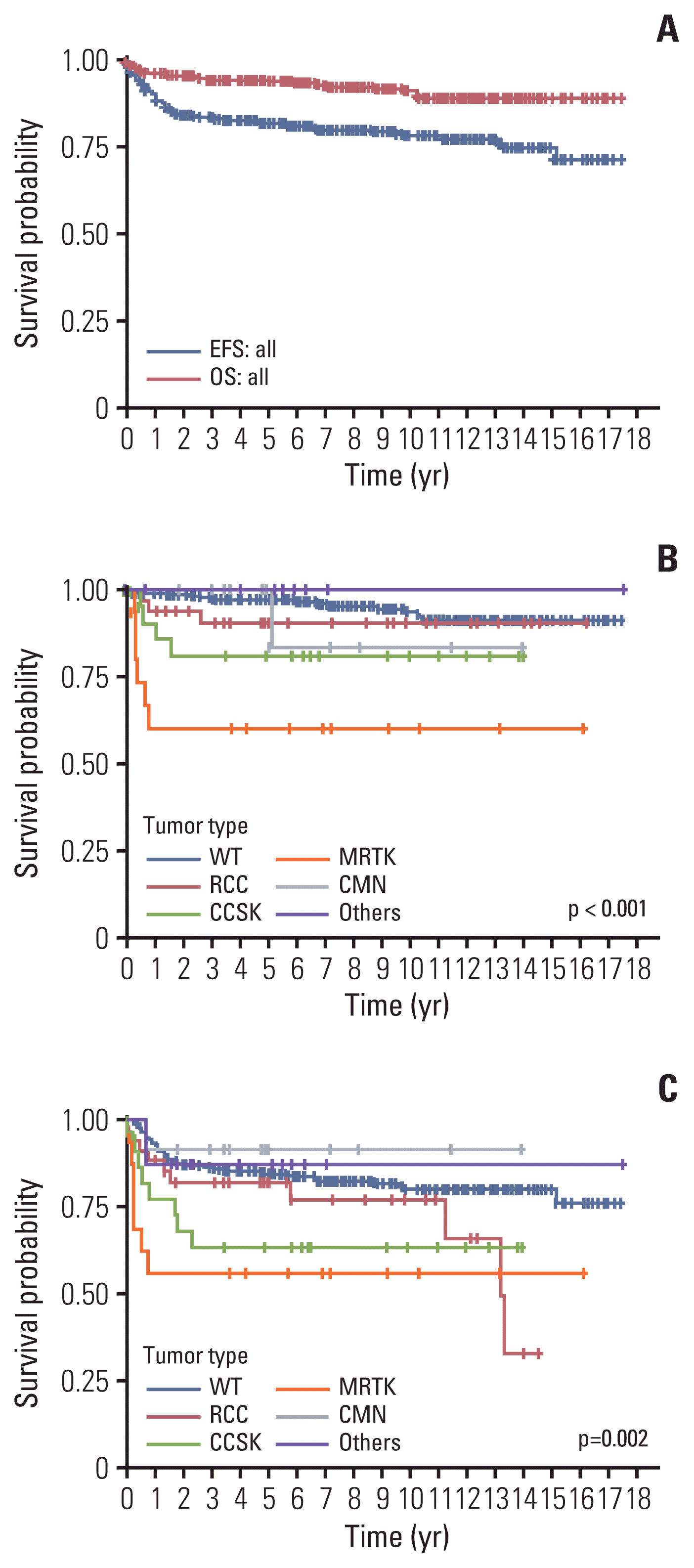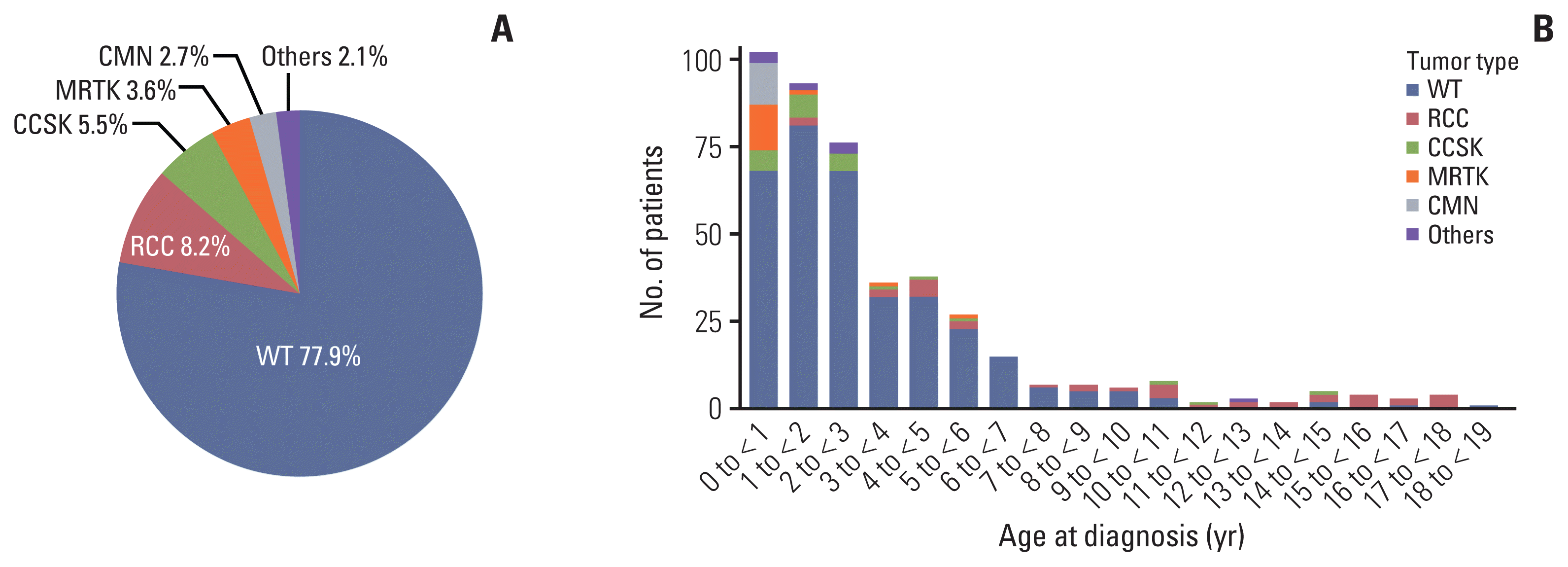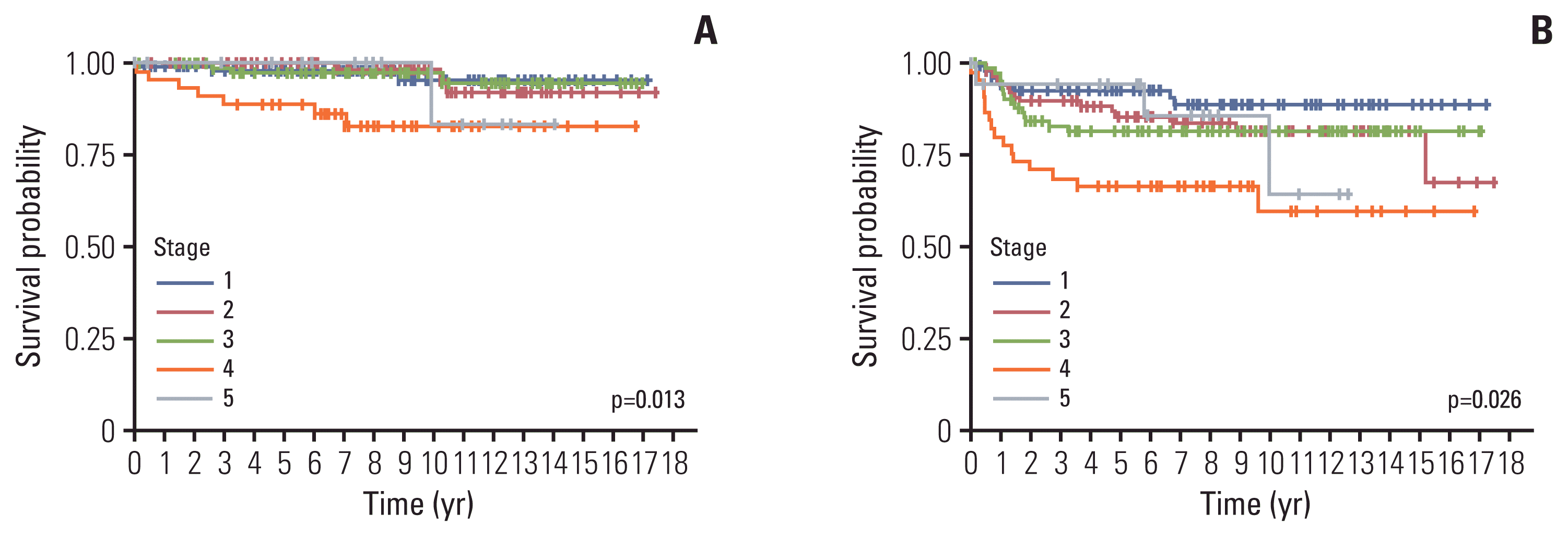1. Brok J, Treger TD, Gooskens SL, van den Heuvel-Eibrink MM, Pritchard-Jones K. Biology and treatment of renal tumours in childhood. Eur J Cancer. 2016; 68:179–95.
2. Chung EM, Graeber AR, Conran RM. Renal tumors of childhood: radiologic-pathologic correlation part 1. The 1st decade: from the radiologic pathology archives. Radiographics. 2016; 36:499–522.
3. Nakata K, Colombet M, Stiller CA, Pritchard-Jones K; Steliarova-Foucher E; IICC-3 Contributors. Incidence of childhood renal tumours: an international population-based study. Int J Cancer. 2020; 147:3313–27.
4. Ray S, Jones R, Pritchard-Jones K, Dzhuma K, van den Heuvel-Eibrink M, Tytgat G, et al. Pediatric and young adult renal cell carcinoma. Pediatr Blood Cancer. 2020; 67:e28675.
5. Nakata K, Williams R, Kinoshita Y, Koshinaga T, Moroz V, Al-Saadi R, et al. Comparative analysis of the clinical characteristics and outcomes of patients with Wilms tumor in the United Kingdom and Japan. Pediatr Blood Cancer. 2021; 68:e29143.
6. Loke BN, Wong MK, Tawng KD, Kuick CH, Jain S, Lian D, et al. Clinical, pathological and loss of heterozygosity differences in Wilms tumors between Asian and non-Asian children. Int J Cancer. 2019; 144:1234–42.
7. Ooms A, Vujanic GM, D’Hooghe E, Collini P, L’Hermine-Coulomb A, Vokuhl C, et al. Renal tumors of childhood: a histopathologic pattern-based diagnostic approach. Cancers (Basel). 2020; 12:729.
8. Scott RH, Stiller CA, Walker L, Rahman N. Syndromes and constitutional chromosomal abnormalities associated with Wilms tumour. J Med Genet. 2006; 43:705–15.
9. Liu EK, Suson KD. Syndromic Wilms tumor: a review of predisposing conditions, surveillance and treatment. Transl Androl Urol. 2020; 9:2370–81.
10. Jain J, Sutton KS, Hong AL. Progress update in pediatric renal tumors. Curr Oncol Rep. 2021; 23:33.
11. Oue T, Fukuzawa M, Koshinaga T, Okita H, Nozaki M, Chin M, et al. Management of pediatric renal tumor: past and future trials of the Japan Wilms Tumor Study Group. Pediatr Int. 2015; 57:828–31.
12. Dome JS, Graf N, Geller JI, Fernandez CV, Mullen EA, Spreafico F, et al. Advances in Wilms tumor treatment and biology: progress through international collaboration. J Clin Oncol. 2015; 33:2999–3007.
13. Pater L, Melchior P, Rube C, Cooper BT, McAleer MF, Kalapurakal JA, et al. Wilms tumor. Pediatr Blood Cancer. 2021; 68(Suppl 2):e28257.
14. Aldrink JH, Heaton TE, Dasgupta R, Lautz TB, Malek MM, Abdessalam SF, et al. Update on Wilms tumor. J Pediatr Surg. 2019; 54:390–7.
15. Suh WS, Kang IJ, Koo HH, Kook H, Kim SK, Kim HK, et al. Epidemiology and clinical outcomes of childhood Wilms tumor in Korea. Korean J Pediatr Hematol Oncol. 204. 11:164–70.
16. Park HJ, Moon EK, Yoon JY, Oh CM, Jung KW, Park BK, et al. Incidence and survival of childhood cancer in Korea. Cancer Res Treat. 2016; 48:869–82.
17. Ahmed HU, Arya M, Levitt G, Duffy PG, Mushtaq I, Sebire NJ. Part I: Primary malignant non-Wilms’ renal tumours in children. Lancet Oncol. 2007; 8:730–7.
18. van den Heuvel-Eibrink MM, van Tinteren H, Rehorst H, Coulombe A, Patte C, de Camargo B, et al. Malignant rhabdoid tumours of the kidney (MRTKs), registered on recent SIOP protocols from 1993 to 2005: a report of the SIOP renal tumour study group. Pediatr Blood Cancer. 2011; 56:733–7.
19. Furtwangler R, Gooskens SL, van Tinteren H, de Kraker J, Schleiermacher G, Bergeron C, et al. Clear cell sarcomas of the kidney registered on International Society of Pediatric Oncology (SIOP) 93-01 and SIOP 2001 protocols: a report of the SIOP Renal Tumour Study Group. Eur J Cancer. 2013; 49:3497–506.
20. Park JE, Noh OK, Lee Y, Choi HS, Han JW, Hahn SM, et al. Loss of heterozygosity at chromosome 16q is a negative prognostic factor in Korean pediatric patients with favorable histology Wilms tumor: a report of the Korean Pediatric Hematology Oncology Group (K-PHOG). Cancer Res Treat. 2020; 52:438–45.
21. Vujanic GM, Gessler M, Ooms A, Collini P, Coulomb-l’Hermine A, D’Hooghe E, et al. The UMBRELLA SIOP-RTSG 2016 Wilms tumour pathology and molecular biology protocol. Nat Rev Urol. 2018; 15:693–701.
22. de la Monneraye Y, Michon J, Pacquement H, Aerts I, Orbach D, Doz F, et al. Indications and results of diagnostic biopsy in pediatric renal tumors: a retrospective analysis of 317 patients with critical review of SIOP guidelines. Pediatr Blood Cancer. 2019; 66:e27641.
23. Rossoff J, Tse WT, Duerst RE, Schneiderman J, Morgan E, Kletzel M, et al. High-dose chemotherapy and autologous hematopoietic stem-cell rescue for treatment of relapsed and refractory Wilms tumor: re-evaluating outcomes. Pediatr Hematol Oncol. 2018; 35:316–21.
24. Qureshi SS, Bhagat M, Verma K, Yadav S, Prasad M, Vora T, et al. Incidence, treatment, and outcomes of primary and recurrent Non-Wilms renal tumors in children: report of 109 patients treated at a single institution. J Pediatr Urol. 2020; 16:475.
25. Saula PW, Hadley GP. Pediatric non-Wilms’ renal tumors: a third world experience. World J Surg. 2012; 36:565–72.
26. Geller JI, Cost NG, Chi YY, Tornwall B, Cajaiba M, Perlman EJ, et al. A prospective study of pediatric and adolescent renal cell carcinoma: a report from the Children’s Oncology Group AREN0321 study. Cancer. 2020; 126:5156–64.
27. Seibel NL, Chi YY, Perlman EJ, Tian J, Sun J, Anderson JR, et al. Impact of cyclophosphamide and etoposide on outcome of clear cell sarcoma of the kidney treated on the National Wilms Tumor Study-5 (NWTS-5). Pediatr Blood Cancer. 2019; 66:e27450.
28. Tomlinson GE, Breslow NE, Dome J, Guthrie KA, Norkool P, Li S, et al. Rhabdoid tumor of the kidney in the National Wilms’ Tumor Study: age at diagnosis as a prognostic factor. J Clin Oncol. 2005; 23:7641–5.
29. Gooskens SL, Houwing ME, Vujanic GM, Dome JS, Diertens T, Coulomb-l’Hermine A, et al. Congenital mesoblastic nephroma 50 years after its recognition: a narrative review. Pediatr Blood Cancer. 2017; 64:e26437.
30. Ahmed HU, Arya M, Levitt G, Duffy PG, Sebire NJ, Mushtaq I. Part II: Treatment of primary malignant non-Wilms’ renal tumours in children. Lancet Oncol. 2007; 8:842–8.





 PDF
PDF Citation
Citation Print
Print





 XML Download
XML Download